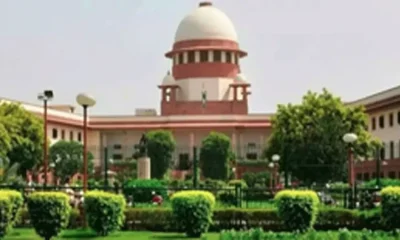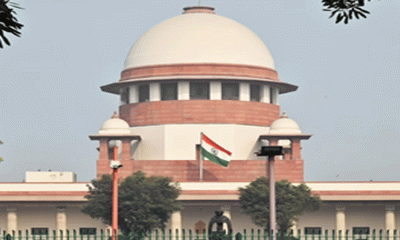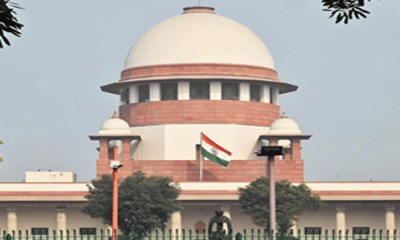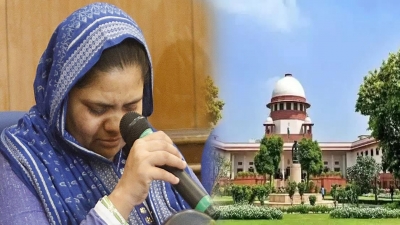National News
Golf course has dress code, can students come in minis, asks SC in Hijab row hearing
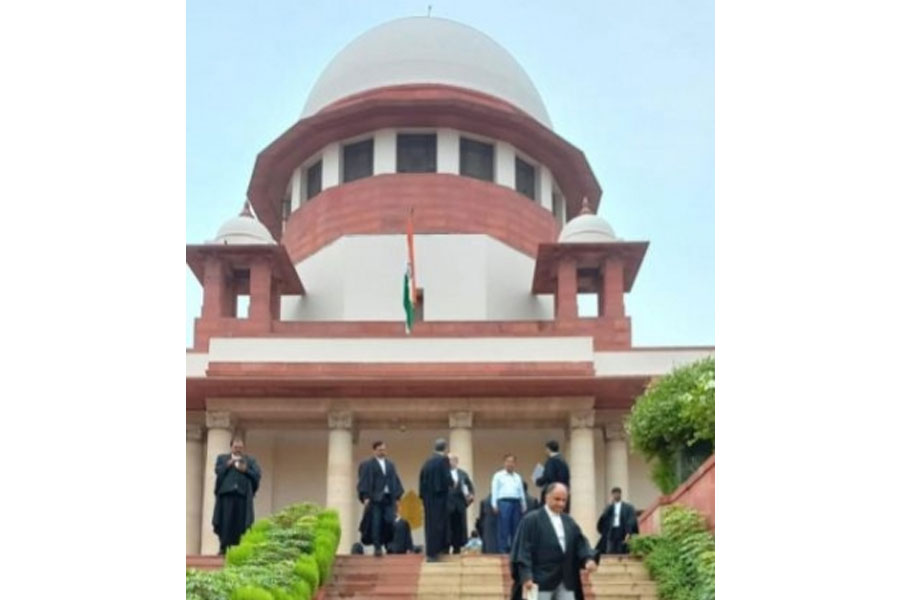
The Supreme Court on Monday shot a volley of questions at petitioners’ counsel challenging the ban on wearing of hijab in government colleges in Karnataka, wondering whether a student’s choice of wearing minis to the classroom would be justified, and highlighted that a dress code is applicable on a golf course, restaurant, and courtroom.
A bench of Justices Hemant Gupta and Sudhanshu Dhulia said wearing hijab might be a religious practice, but the question is can one take hijab to a school where a uniform is prescribed? The bench orally observed Karnataka’s government’s order allowing college development committees to prescribe uniforms did not appear to violate the right to education.
Justice Gupta queried senior advocate Sanjay Hedge, representing one of the petitioners, if the absence of a prescription of a dress code would enable the students to wear anything to the classroom. “Can students come in minis… whatever they want when there is no prescription, would the executive power of state come in?”
“You are saying Act (Karnataka Education Act) doesn’t prescribe dress code and does not debar prescription either. Does it exclude the state then?”
“You may have a religious right…. can you take that right within an educational institution where a uniform is prescribed. You may be entitled to wear the hijab or scarf; can you carry the right within an educational institution (where a uniform has been prescribed).”
At the beginning of the hearing, senior advocate Rajeev Dhavan, representing one of the petitioners, submitted the case raises an important question, whether hijab is essential to Islam or not. He said hijab is worn in a large number of countries throughout the world and the case involves a constitutional question which has not been dealt with earlier.
The Karnataka government, led by Advocate General Prabhuling K. Navadgi submitted that “we have left it to the institution concerned. The government purposefully left it to the college development council.” He added that to his knowledge, at least two colleges in Udupi allowed Hijab.
Additional Solicitor General K.M. Nataraj, also representing Karnataka, submitted discipline in colleges was only the issue, but petitioners were unnecessarily expanding it and some under the guise of religious practices wanted to violate it.
Hedge tried to link wearing of hijab with modesty and dignity of girls, and added that most girls’ colleges prescribe salwar kameez and dupatta. He argued further, can one ask women not to wear a chunni on head, for example in Patiala? Can one control the modesty of a woman?
The bench said even courtrooms have a dress code, for example could a woman wear jeans to the courtroom saying it’s her choice, there is a dress code on a golf course, which is a public space, and also certain restaurants have a dress code and they do not allow people in shorts. “Can a person say I won’t follow dress code but still have access?” it asked.
Hedge said the golf course is private property. The bench replied that this is not always the case.
Hedge argued that under the rule making power of the Karnataka Education Act, the executive cannot violate the fundamental rights. The bench noted that the government is not denying the right to education, but they are saying that you have to come in uniform. The bench has scheduled the matter for further hearing on Wednesday at 2 pm.
The top court was hearing a clutch of petitions against the Karnataka High Court judgment, which upheld the right of educational institutions to ban wearing of hijab in pre-university colleges in the state.
National News
‘Insult to Mahatma Gandhi’: Oppn protests outside Parliament against move to replace MGNREGA

New Delhi, Dec 16: The Opposition on Tuesday staged a protest outside Parliament, holding placards and raising slogans against the Centre over its move to replace the Mahatma Gandhi National Rural Employment Guarantee Act (MGNREGA).
Raising slogans such as “Gandhiji ka ye apman, nahi sahega Hindustan” and “Mahatma Gandhi Amar Rahe”, Opposition parliamentarians accused the BJP-led Centre of removing the name of the Father of the Nation, Mahatma Gandhi, from the rural employment scheme.
Opposition MPs objected to the renaming of the flagship employment programme and marched within the Parliamentary premises to the statue of Mahatma Gandhi, where they continued their protest.
The demonstration followed the introduction of the Viksit Bharat Guarantee for Rozgar and Ajeevika Mission (Gramin) (VB-G RAM G), 2025, a Bill that seeks to replace the Mahatma Gandhi National Rural Employment Guarantee Act.
Union Minister Shivraj Singh Chouhan introduced the Bill in the Lok Sabha on Tuesday, triggering sharp reactions from Opposition members who questioned the rationale behind removing Mahatma Gandhi’s name from a landmark welfare scheme that has been in existence for nearly two decades.
“The truth is that under the pretext of changing the scheme’s name, they want to scrap it. Why do they want to change the name of this scheme? Mahatma Gandhi is the Father of the Nation,” Congress MP Priyanka Gandhi Vadra told reporters during the protest.
Samajwadi Party chief Akhilesh Yadav, speaking to Media, questioned the logic behind the “renaming” exercise. “How will the change in the name benefit the farmers of the country? This politics of changing the name first started in Uttar Pradesh, and now it has arrived in Delhi also,” he said.
Congress General Secretary K.C. Venugopal also strongly criticised the Centre for replacing the scheme.
Speaking to Media, Venugopal said, “This is an insult to the Father of the Nation, Mahatma Gandhi. We are protesting because this is basically the anti-national attitude of the BJP to insult Mahatma Gandhi and kill the MGNREGA scheme.”
Samajwadi Party MP Awadhesh Prasad told Media, “This is an insult to Mahatma Gandhi, the Father of the Nation. Lord Ram is respected in the entire country and the world. The one who is insulting Lord Ram is these people (ruling party).”
The Opposition maintained that the proposed replacement of MGNREGA and the removal of Mahatma Gandhi’s name reflected a deeper attempt to dilute a crucial employment guarantee programme.
National News
‘Person Of CM’s Calibre Behaved So Disrespectfully’: Abu Azmi SLAMS Bihar CM Nitish Kumar For Pulling Down Woman Doctor’s Hijab, Demands Apology
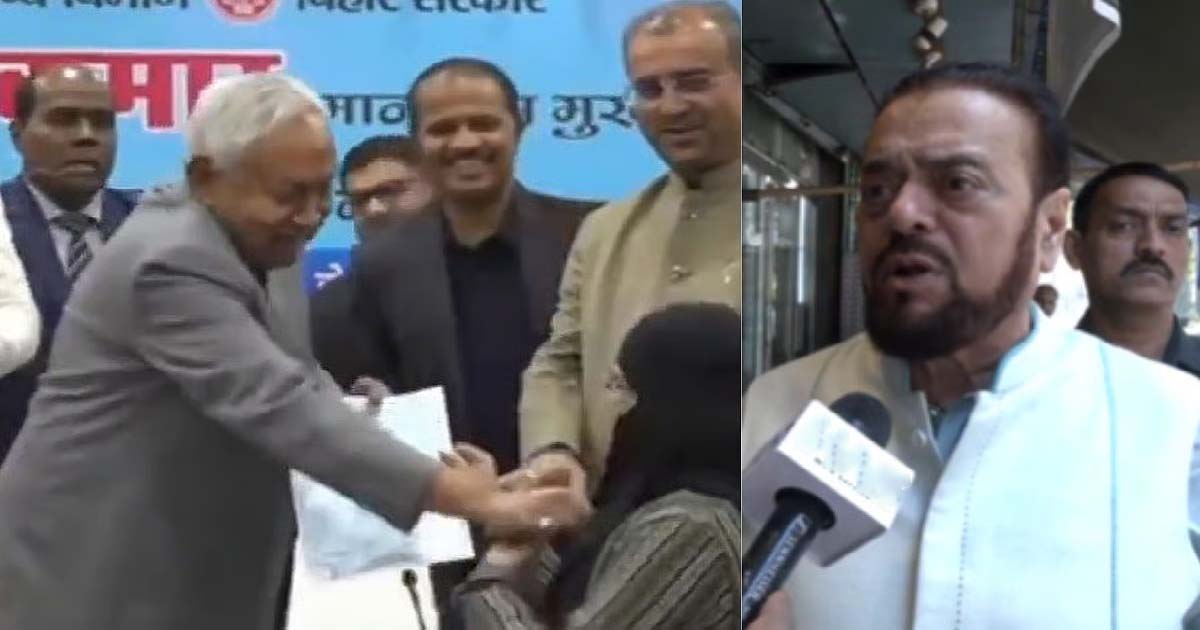
Mumbai: The Samajwadi Party state president, Abu Azmi, on Tuesday, December 16, hit out at Bihar Chief Minister Nitish Kumar after a video from a government event in Patna went viral on social media. The clip triggered outrage as it showed the Bihar CM pulling down a woman doctor’s hijab while presenting her appointment letter.
While speaking to media, Abu Azmi said that he is deeply saddened as a person of the Chief Minister’s calibre, served as CM multiple times and is a senior leader, behaved so disrespectfully towards a woman.
Calling it unacceptable, he added that “If a woman wears a burqa, it is her personal choice, and forcibly pulling it off with one’s hand sends a message that the lives of Muslims have no value and anyone can remove their burqa.”
The Samajwadi Party state president said that the Bihar CM should apologise to the woman for his disrespectful behaviour. “I appeal to the people to protest against him, and until he apologises to the woman and she herself forgives him, he should not be spared…”
The incident reportedly took place on Monday during an official function where Kumar was distributing certificates to AYUSH (Ayurveda, Yoga & Naturopathy, Unani, Siddha and Homoeopathy) doctors.
The woman seen in the video has been identified as Nusrat Parveen. In the footage, Nitish Kumar is seen asking her about her headscarf after handing over the appointment letter and is seen pulling down her hijab himself. The woman appeared visibly shocked by the Chief Minister’s action.
The Bihar CM distribution ceremony of appointment letters for 1283 AYUSH doctors (Ayurvedic, Homoeopathic, and Unani) was held at ‘Samvad’ in the Chief Minister’s Office.
National News
Mumbai Local Train Update: Thane-Kalyan Route May Get Underground Rail Lines As Central Railway Explores Options To Tackle Congestion

Mumbai: In a bid to tackle severe congestion on the crucial Thane–Kalyan rail corridor, the Central Railway (CR) is actively exploring the possibility of laying underground rail lines as part of its proposed 7th and 8th lines project.
The 10.8-km Thane–Kalyan stretch, one of the busiest sections on Mumbai’s suburban network, handles nearly 1,000 train movements daily and serves as a vital interchange zone for lakhs of commuters. With land constraints posing a major challenge, railway authorities believe that going underground at select locations, especially near Dombivli, could be key to easing long-term pressure.
CR officials confirmed that a third-party agency has been appointed to conduct a Final Location Survey (FLS), which will determine the feasibility, alignment and engineering details of the new rail lines. The study, currently in its early stages, will assess whether underground corridors are required in densely built-up pockets where horizontal expansion is no longer possible. The FLS report is expected to be ready by mid-2026.
The Thane–Kalyan section is a critical rail artery where multiple routes intersect. Thane station links the main line with the trans-harbour corridor towards Panvel, Diva connects suburban services to Roha and Kalyan marks the bifurcation of routes towards Kasara and Karjat–Khopoli. With the rapid expansion of the Mumbai Metropolitan Region, nearly 1.2 to 1.5 million commuters depend on this corridor every day, intensifying congestion during peak hours.
Central Railway had completed the long-delayed 5th and 6th lines between Thane and Diva in 2022, offering some relief. However, officials admit that this has only partly addressed the issue. While there is limited scope for surface-level expansion on certain stretches, areas before and after Dombivli are particularly constrained, leading a serious consideration of underground rail sections.
Currently, around 1,200 suburban local services operate daily between Thane and Kalyan on fast and slow corridors. Diva station remains one of the busiest points on the CR network, with nearly 70–75 per cent of the 894 daily local trains halting there. This has also led to frequent closures of the Diva level crossing, opened nearly 39 times a day, disrupting both train schedules and road traffic.
The proposed underground and elevated additions are part of a larger vision to segregate suburban and long-distance train operations. Central Railway plans to expand Lokmanya Tilak Terminus (LTT) with additional platforms and develop Parel as a new terminus, reducing pressure on CSMT and Dadar.
While underground lines could transform mobility on the Thane–Kalyan corridor, officials acknowledge that planning, approvals and execution will take several years before commuters see tangible benefits.
-

 Crime3 years ago
Crime3 years agoClass 10 student jumps to death in Jaipur
-

 Maharashtra1 year ago
Maharashtra1 year agoMumbai Local Train Update: Central Railway’s New Timetable Comes Into Effect; Check Full List Of Revised Timings & Stations
-

 Maharashtra1 year ago
Maharashtra1 year agoMumbai To Go Toll-Free Tonight! Maharashtra Govt Announces Complete Toll Waiver For Light Motor Vehicles At All 5 Entry Points Of City
-

 Maharashtra1 year ago
Maharashtra1 year agoFalse photo of Imtiaz Jaleel’s rally, exposing the fooling conspiracy
-

 National News1 year ago
National News1 year agoMinistry of Railways rolls out Special Drive 4.0 with focus on digitisation, cleanliness, inclusiveness and grievance redressal
-

 Maharashtra1 year ago
Maharashtra1 year agoMaharashtra Elections 2024: Mumbai Metro & BEST Services Extended Till Midnight On Voting Day
-

 National News1 year ago
National News1 year agoJ&K: 4 Jawans Killed, 28 Injured After Bus Carrying BSF Personnel For Poll Duty Falls Into Gorge In Budgam; Terrifying Visuals Surface
-

 Crime1 year ago
Crime1 year agoBaba Siddique Murder: Mumbai Police Unable To Get Lawrence Bishnoi Custody Due To Home Ministry Order, Says Report



